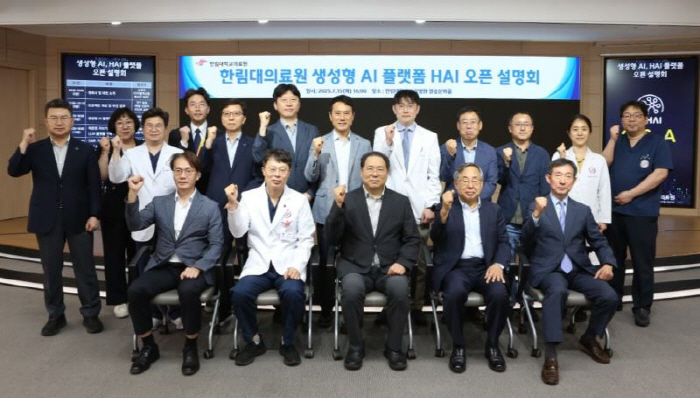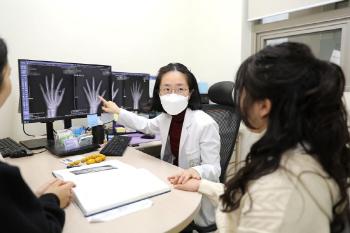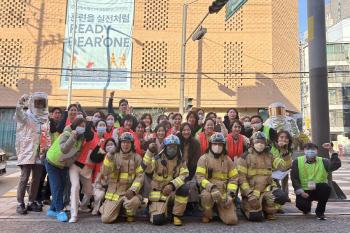Hallym University Medical Center Builds Generative AI Platform HAI...Focus on treatment efficiency and patient safety
Hallym University Medical Center (Director Kim Yong-sun) developed a Generative AI platform 'Hallym Artistic Intelligence (HAI)' and held an open briefing session for all faculty and staff at Ilsong Culture Hall of Hallim University Sacred Heart Hospital at 4 p.m. on the 15th.
About 200 people attended the briefing session, including Yoon Hee-sung, chairman of Ilsong Academy, Kim Yong-sun, director of Hallym University Medical Center, Kim Hyung-soo, director of Hallym University Sacred Heart Hospital, Kang Joon-gu, vice chairman of the medical department, and Lee Min-woo, professor of neurology.
The presentation of the briefing session was conducted with ▲ Introduction and demonstration of generative AI platform (PM Jin Jun-seop of Conan Technology) ▲ Case of establishing knowledge-based AI service and LLM platform at medical center (Kim Dong-sik, chief of digital innovation team at Hanlim University Medical Center) ▲ Case of drafting electronic medical record (EMR) and expected effect (Professor Lee Min-woo of neurology department at Hanlim University Sacred Heart Hospital).
Hallym University Medical Center is trying to establish HAI to solve problems in the medical field and provide quick and accurate medical services to patients. Medical staff are suffering from problems such as a shortage of manpower, repetitive administrative work, and record complexity due to the increase in elderly and multi-disease patients.
Recognizing the need for Generative AI to support medical staff's document work and hospital system access to information, Hallym University Medical Center has jointly developed a customized platform that combines natural language-based Generative AI and a large language model (LLM) dedicated to medical centers over the past six months with Conan Technology (CEO Kim Young-sum), an artificial intelligence software company.
One of the key technologies of HAI is 'Drafting Electronic Medical Records (EMR) Records'.
For the first time in Korea, a draft EMR record (hospitalization record, progress record, discharge summary, short-term discharge record, etc.) covering the pre-treatment cycle from hospitalization to discharge is automatically generated based on LLM. Currently, five major diseases are applied: stroke, cholecystitis, cesarean delivery, lens surgery, tonsil and adenoid resection.
The drafting of the EMR archive of HAI considered treatment efficiency and patient safety. Based on patient data in the hospital information system, a total of 97 items for each medical department, disease, and recording site were linked, and functions were applied according to the characteristics of each medical department through 75 prompt design and rule base combination. The automation of drafts of EMR record papers contributes not only to the reduction of writing time, but also to the unification of sentence expressions, quality improvement, and minimization of missing information.
It is directly mounted on EMR, effectively reducing the working hours of medical staff, saving about 83,000 hours of recording time per year. As a result, it is possible to secure an additional 30 days or more per year that can be spent on patient care per medical staff.
In addition, 'knowledge-based AI services' provide various regulations and guidelines from medical centers in the form of 24-hour Q&A based on an intuitive interface. A total of 1057 documents were collected as training data, and the accuracy was over 80%. The latest information can be reflected by document registration without a separate relearning, and the reliability of the response has also improved through document-based evidence search. In addition, general Generative AI services, including summary and translation functions, are also available.
For the establishment of this platform, Hallym University Medical Center systematized unstructured data generated in the actual work process so that it can be used for specialized tasks such as search, analysis, sharing, and AI learning. We also introduce it as a dedicated LLM based on-premises (internal built-in) to enhance information security. In each response, the RAG (Retrieval-augmented Generation) method linked to internal documents was applied to clearly present the source, increasing the reliability.
Professor Lee Min-woo of the Department of Neurology at Hallym University Sacred Heart Hospital (Hallym University Medical Center Generative AI Construction Task Force) said, "It is of great significance in that we have established a Generative AI platform specialized in the medical environment. Through HAI, not only medical staff but also hospital members can focus more on patient care, research, and original work, away from repetitive administrative tasks."
Yoon Hee-sung, chairman of Ilsong Academy, a school corporation, said "This HAI development is a meaningful turning point leading to changes in the medical field amid a growing dependence on digital technology and a shortage of medical personnel."We need an attitude that applies and leads according to the current medical reality, not adapting to AI." In the future, we hope that HAI will grow into an artificial intelligence partner that realizes patient-centered values by expanding to various treatment areas and diseases," he said.
About 200 people attended the briefing session, including Yoon Hee-sung, chairman of Ilsong Academy, Kim Yong-sun, director of Hallym University Medical Center, Kim Hyung-soo, director of Hallym University Sacred Heart Hospital, Kang Joon-gu, vice chairman of the medical department, and Lee Min-woo, professor of neurology.
The presentation of the briefing session was conducted with ▲ Introduction and demonstration of generative AI platform (PM Jin Jun-seop of Conan Technology) ▲ Case of establishing knowledge-based AI service and LLM platform at medical center (Kim Dong-sik, chief of digital innovation team at Hanlim University Medical Center) ▲ Case of drafting electronic medical record (EMR) and expected effect (Professor Lee Min-woo of neurology department at Hanlim University Sacred Heart Hospital).
Hallym University Medical Center is trying to establish HAI to solve problems in the medical field and provide quick and accurate medical services to patients. Medical staff are suffering from problems such as a shortage of manpower, repetitive administrative work, and record complexity due to the increase in elderly and multi-disease patients.
Recognizing the need for Generative AI to support medical staff's document work and hospital system access to information, Hallym University Medical Center has jointly developed a customized platform that combines natural language-based Generative AI and a large language model (LLM) dedicated to medical centers over the past six months with Conan Technology (CEO Kim Young-sum), an artificial intelligence software company.
One of the key technologies of HAI is 'Drafting Electronic Medical Records (EMR) Records'.
For the first time in Korea, a draft EMR record (hospitalization record, progress record, discharge summary, short-term discharge record, etc.) covering the pre-treatment cycle from hospitalization to discharge is automatically generated based on LLM. Currently, five major diseases are applied: stroke, cholecystitis, cesarean delivery, lens surgery, tonsil and adenoid resection.
The drafting of the EMR archive of HAI considered treatment efficiency and patient safety. Based on patient data in the hospital information system, a total of 97 items for each medical department, disease, and recording site were linked, and functions were applied according to the characteristics of each medical department through 75 prompt design and rule base combination. The automation of drafts of EMR record papers contributes not only to the reduction of writing time, but also to the unification of sentence expressions, quality improvement, and minimization of missing information.
It is directly mounted on EMR, effectively reducing the working hours of medical staff, saving about 83,000 hours of recording time per year. As a result, it is possible to secure an additional 30 days or more per year that can be spent on patient care per medical staff.
In addition, 'knowledge-based AI services' provide various regulations and guidelines from medical centers in the form of 24-hour Q&A based on an intuitive interface. A total of 1057 documents were collected as training data, and the accuracy was over 80%. The latest information can be reflected by document registration without a separate relearning, and the reliability of the response has also improved through document-based evidence search. In addition, general Generative AI services, including summary and translation functions, are also available.
For the establishment of this platform, Hallym University Medical Center systematized unstructured data generated in the actual work process so that it can be used for specialized tasks such as search, analysis, sharing, and AI learning. We also introduce it as a dedicated LLM based on-premises (internal built-in) to enhance information security. In each response, the RAG (Retrieval-augmented Generation) method linked to internal documents was applied to clearly present the source, increasing the reliability.
Professor Lee Min-woo of the Department of Neurology at Hallym University Sacred Heart Hospital (Hallym University Medical Center Generative AI Construction Task Force) said, "It is of great significance in that we have established a Generative AI platform specialized in the medical environment. Through HAI, not only medical staff but also hospital members can focus more on patient care, research, and original work, away from repetitive administrative tasks."
Yoon Hee-sung, chairman of Ilsong Academy, a school corporation, said "This HAI development is a meaningful turning point leading to changes in the medical field amid a growing dependence on digital technology and a shortage of medical personnel."We need an attitude that applies and leads according to the current medical reality, not adapting to AI." In the future, we hope that HAI will grow into an artificial intelligence partner that realizes patient-centered values by expanding to various treatment areas and diseases," he said.
|
This article was translated by Naver AI translator.




